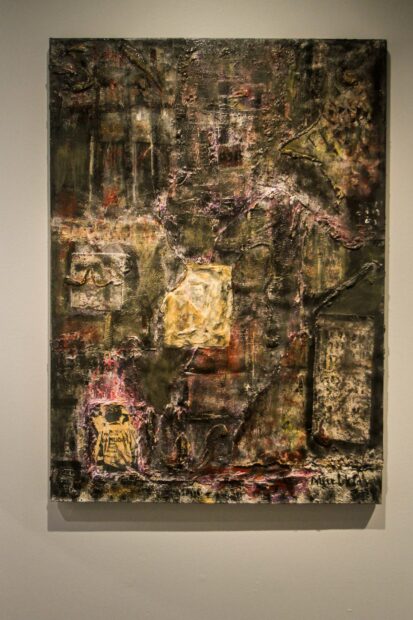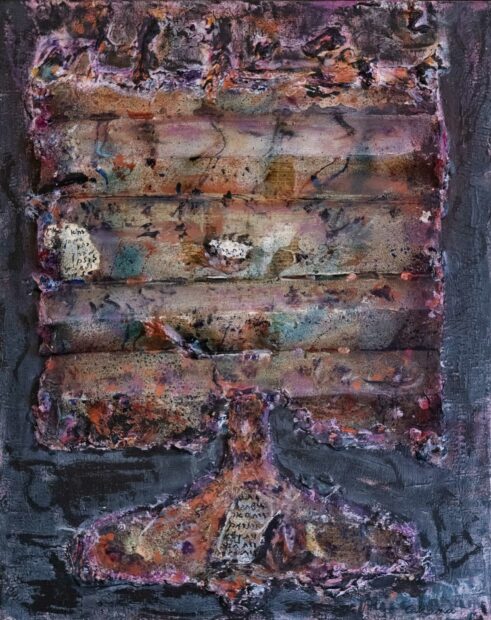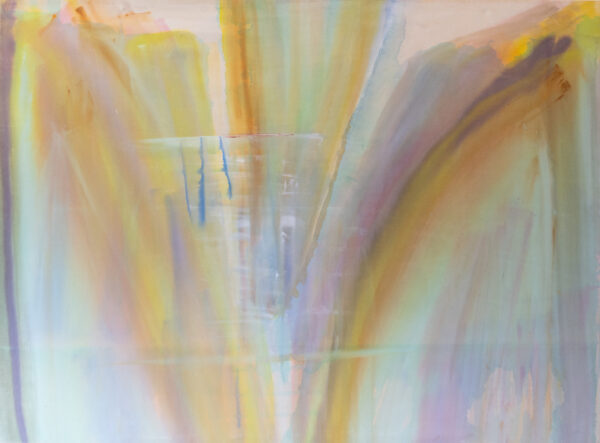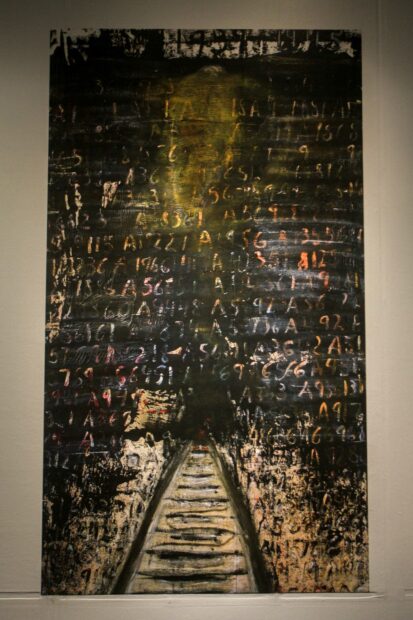
Alice Lok Cahana, “Have You Seen My Sister?,” mixed media on canvas, 61 x 44 inches. On loan from the United States Holocaust Memorial Museum
The Alice Cahana I knew was gracious, elegant, and passionate about her artwork. Cahana spent a year and a half imprisoned in Nazi concentration camps during World War II, and she was dedicated to ensuring no one ever forgot the horrors they inflicted on their captives, in part by using her artwork to relate her experiences.
Cahana died in 2017, but her collaged paintings, drawings, and etchings live on to tell her story. To highlight this abundance of work, Holocaust Museum Houston Chief Curator Carol Manley organized The Life and Art of Alice Lok Cahana, on view through April 9, 2023 in the institution’s Josef and Edith Mincberg Gallery.

Alice Lok Cahana, “Have You Seen My Sister?” (detail), mixed media on canvas, 61 x44 inches. On loan from the United States Holocaust Memorial Museum
She was born Alice Lok in Sárvár, Hungary in 1929. Her father, a textile merchant, was in Budapest on business when the Germans invaded her town. Cahana was just 14 when she, her mother, brother, and sister were taken from their home. Along with her sister, Edith, she was transported by train to Auschwitz. Her long braids were cut off and she was dressed in prison clothes. The pair kept their sisterhood a secret so they wouldn’t be separated.
Cahana never saw her mother and brother again. Liberated on April 15, 1945, from Bergen-Belsen, she was one of those fortunate to have survived. During this time she lost track of Edith, who was hospitalized in a makeshift Red Cross hospital after the liberation; she searched for her for years. A painting from 1988, titled Have You Seen My Sister?, references this time. On loan from the United States Holocaust Memorial Museum, it is a large dark work with shadowy prison bars and closed doors. Collaged into the center in a pool of light is a photograph of Cahana sister. During the filming of The Last Days by Steven Spielberg, a documentary about the Holocaust in which the artist appears, she was able to locate Edith’s grave. Cahana’s father, on the other hand, was one of the Jews rescued by Swedish businessman Raoul Wallenberg, who saved roughly 100,000 people by giving them Swedish passports.
After being liberated, Cahana went first to a rehabilitation center in Sweden and then to Budapest. Finding Hungary to be too painful, she joined the exodus to Israel, where she met her husband, Rabbi Moshe Cahana, a young independence fighter. They then returned to Sweden to work with the refugees, and later emigrated to America. The couple and their son, Ronnie, moved to Houston in 1957, when Moshe became the first rabbi of Congregation Brith Shalom in Bellaire.
Cahana studied art at the University of Houston and Rice University. Her early paintings were abstract color fields, reflecting the painting style that dominated the Houston art scene in the 1950s and 1960s. One work in the show reflects this period. Although the title and date are unknown, this early piece is a large abstract color study similar to Morris Louis’s veil paintings and Helen Frankenthaler’s stained canvas — a canvas coated in thin washes of paint that create lyrical “fields” of color.

Alice Lok Cahana, “Tree of Life,” 41 x 33 inches framed. On loan from Drs. Judith and Harvey Rosenstock.
In 1978, everything changed. Cahana visited Sárvár for the first time since the war. According to Cahana’s 1988 interview with Hank Bouchard of the Washington Post, “Nobody in my village wondered what had become of us, nobody cared what had become of a whole town of children.” Neighbors had taken over her old home place and the Cahana carpet factory. Sárvár‘s Jews, who had shared the town’s life and labor for a thousand years, were all gone, and there was no monument to tell how they had been consumed in the Holocaust. Cahana continued: “But now I remembered what I had said to myself, standing by the fence in the camp, a girl 15 years old: ‘If I survive, I will tell the story.'”
All of Cahana’s subsequent work reflects her experiences during the Holocaust. Using paint, collage, newspaper clippings, photographs, lines from poems written by children in the camps, and pages from her mother’s prayer book (which miraculously survived), she created a powerful body of work tempered with a delicate sensibility.
Several of Cahana’s paintings reference the children who suffered in the camps. Some 15,000 children were taken to Terezin, a concentration camp 30 miles north of Prague, and held there for months before being dispersed by rail to extermination camps. Some poems by the children have survived; the title of I Still Believe #2 is taken from one of them. Cahana was moved by the children’s hope and their innocent belief in the human spirit.
One of the great joys of Cahana’s life took place in 2006, when she was invited to the Vatican Museum in Rome to present Pope Benedict XVI with No Names, a dark, abstract piece about her first moments at Auschwitz. The painting depicts train tracks that disappear into the darkness of the camp. The surface is covered in numbers, representing those that were tattooed on the prisoners’ arms. “They counted us twice a day,” Cahana told me in 1981. “Name, date, name, date. It went on and on. Only the brain was working, not the soul.”
This exhibition of 22 multi-media works includes two large pieces on loan from the United States Holocaust Memorial Museum, five works owned by Holocaust Museum Houston, and pieces on loan from the artist’s family and local friends and collectors. In addition, there are four video screens — at the entrance is an older video produced by the Holocaust Museum years ago, which tells Cahana’s story. There is also an excerpt from the Spielberg documentary. The other two play personal stories and memories about the artist, told by family members, friends of the artist, and her collectors.
The works is as resonant now as it ever was. As I wrote in Artspace magazine in the Winter 1987-88 issue: “Cahana begins her paintings with certain carefully selected images and then allows her subconscious to act on them. One senses that her work flows out of her, spills onto the canvas in a torrent of paint and emotional release. Rectangles become windows to freedom, arches become ovens, black lines become railroad ties, numbers become endless days in a senseless calendar, a spray of red paint becomes the spilled blood of the victims…. Through it all, however, shines Cahana’s belief that the spirit of man [and woman] can survive any horror and eventually triumph over evil.”
Cahana spent her last years in Portland, Oregon, where she moved with her daughter, Rina, after Rabbi Moshe Cahana died in 2004. She passed away on November 28, 2017, at the age of 88. She is survived by her three children, Ronnie, Michael, and Rina, and their families.
The Life and Art of Alice Lok Cahana is on view at Holocaust Museum Houston through April 9, 2023.




